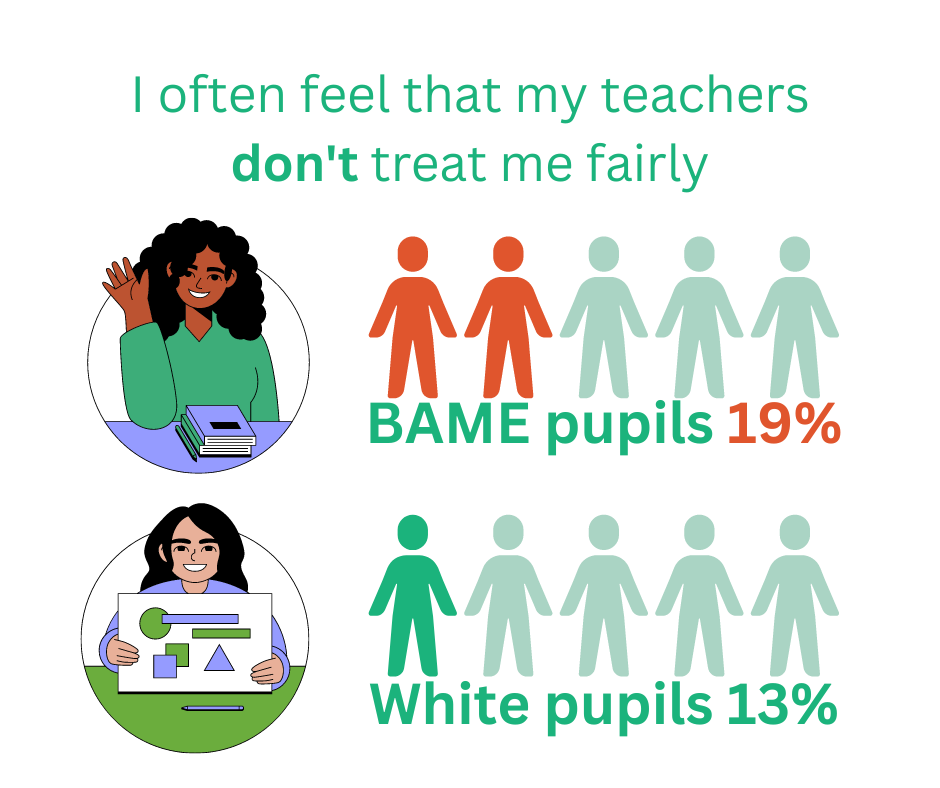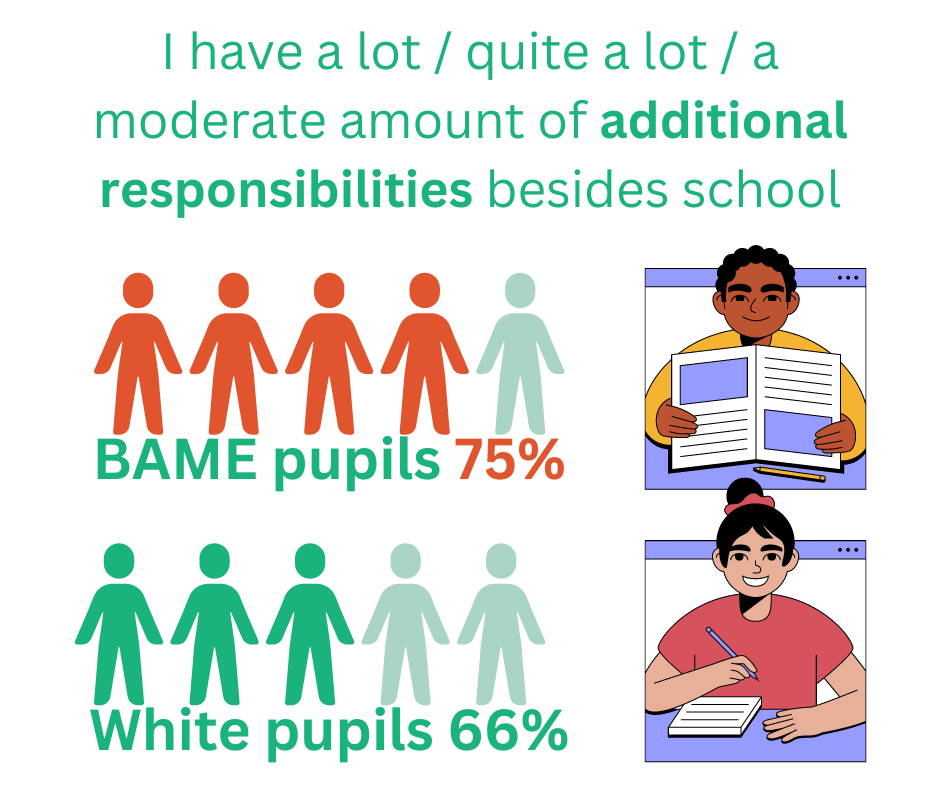26 October, 2022
Race and ethnicity
Black, Black British, Black Caribbean or African pupils responded less positively than White English, Welsh, Scottish, Northern Irish or British students to the question, “How often do you feel that your teachers treat you fairly?”.
Ethnic and Racial Disparities among Pupils in English Schools
October is when Black History Month is observed in the UK. Culture Amp defines Black History Month as a national celebration which aims to “promote and celebrate the contributions of those with African and Caribbean heritage to British society and to foster an understanding of Black history in general.” Within this blog, we dissect pupils’ learning and wellbeing experiences, looking at the ethnic and racial disparities in English schools.
Education Outcome Landscapes for Ethnic Minorities
Minority ethnic children in England are growing in number. Evidence suggests that they are significantly disadvantaged regarding family socioeconomic status and educational and health outcomes. Throughout this blog, we look at just what this disadvantage looks like from the pupils’ perspective.
The Race Equality Foundation highlights that
“There was significant variation in educational outcomes for BAME students. Whilst some (e.g. Chinese and Indian students) show significant success in attainment throughout all phases of education, others, such as the Black Caribbean and Bangladeshi pupils, continue to underachieve.”
They also highlight the impact of Covid-related education measures (i.e. distance learning) on the disparity between groups and point out that it acted as a catalyst for growing differences between socio-economic classes.
This can be seen in the differences in academic achievements between ethnic groups. For instance, the NFER data in the graph below shows a positive correlation between the percentage of BAME students and those needing intensive catch-up support following education disruption (COVID-19).
Flair Impact highlight the statistic that 19% of students feel that their ethnicity is a barrier to being themselves at school. A statistic such as this highlights gaps in sector understanding when it comes to equality, diversity and inclusion and justifies the continued efforts of educators and leaders to continue to push for EDI-based policy and training for all settings.
If we look at academic achievement reports from the Department of Education, we can see that Black students are 2% less likely to achieve a grade 5 or above in English and maths GCSE than White students, further deepening the ethnic and racial disparities among them. Black Caribbean students are also 15% less likely to achieve grade 5 in English and Maths GCSE. Black African students are actually 2.7% more likely to achieve these grades, with 53.6% achieving a grade 5 in English and Maths GCSEs.
Exclusion and Suspension Statistics
Teach First recently wrote about racism in schools and touched on the higher (in some cases three times higher) exclusion rates for Black Caribbean pupils as opposed to White pupils. If we look at the permanent exclusion rates shared by the Department for Education, we can see a similar picture:
The Department for Education data shows that mixed-race and Black students were almost always more likely to be permanently excluded from schools. The only exception was state-funded primary schools where Black and White students were just as likely to be excluded.
The National Education Union highlights the importance of creating a sense of belonging for students from ethnic minority backgrounds, especially Black students. They state that this could positively affect exclusion rates and other areas of concern relating to educational inequalities. The NEU report also highlights how a sense of belonging has been linked to increased student motivation, increased staff well-being, motivation and retention, reductions in student absenteeism, and other positive social outcomes, e.g., health and wellbeing and improved academic achievement, among some of the listed benefits.
Ethnic and Racial Disparities
Pupil Experience of Behaviour
When looking at our Pupil Wellbeing Survey data, we can analyse the experiences of different groups of pupils by looking at the reported answers to questions that look at their day-to-day experiences. Here we look at the similarities and differences between Black, Black British, Caribbean or African students and White – English/Welsh/Scottish/Northern Irish/ British students’ experiences of behaviour in school.
If we look at the data here, It can be seen that Black students are more likely to self-identify as behaving worse in the classroom and out of the classroom during breaks. This difference is only slight. However, as previously stated in this blog, exclusion rates for Black Caribbean pupils, as opposed to White pupils, were almost three times higher. This increased number of exclusions and the data from our observations suggest that Black school pupils’ experiences of behaviour differ from White – English/Welsh/Scottish/Northern Irish/ British Students.
Pupils’ Learning experiences
Another pupil experience that can be compared is the pupil learning experience. This includes pupils’ workloads, their experiences of how their teachers treat them, and how represented in the curriculum they feel.
Black, Black British, Black Caribbean or African pupils responded less positively than White English/Welsh/Scottish/Northern Irish/ British students to the question, “How often do you feel that your teachers treat you fairly?”. Although the difference between the negative response percentages was minimal, there is a perceived difference in the data indicating substantial ethnic and racial disparities.
When the same pupils were asked, “how much other work or responsibilities do you have besides school?” 75% of Black students state they had “a lot, quite a lot, or a moderate amount” compared with 66% of White students.
The Race Equality Foundation highlights significant variation in educational outcomes for BAME students through all phases of education, stating that Black Caribbean students are much more likely to underachieve. With Black pupils more likely to report that they are being treated less fairly in our survey data and more likely to have other work or responsibilities besides school, it is understandable to see that pupils’ experiences within education can differ depending on pupils’ ethnicity. Our Data also found that Black, Black British, Black Caribbean, or African pupils also felt underrepresented by the curriculum, with 36% of pupils of these ethnicities stating they rarely or never felt that the curriculum reflects people like them. Suggesting that pupils couldn’t relate to the experiences/ content within the curriculum and, in turn, could feel underrepresented.
Two Ways to Make Education More Inclusive
Zero Tolerance to Racism Cultures, Synergised with Education
Zero tolerance policies within the school environment support the development of broader cultural and social understanding by outlining appropriate and inappropriate behaviours, and will, in turn, impact out-of-school and home environments too. Zero tolerance cultures can also help staff, by encouraging pupils affected by inappropriate and abusive behaviour, from peers, to speak out when affected. This, in turn, offers support for students who need it most and could support the growth of cultural understanding within the school community, in which pupils learn what is, for example, racist behaviour.
However, zero-tolerance policies can lead to increased exclusions; BLAM suggests that there has been a steady increase in UK schools adopting the use of zero-tolerance behaviour policies. The claim is that this specific type of policy increases the likely hood of pupils in general, but Black pupils in particular, to be placed in Pupil Referral Units (PRU) or Alternative Provisions (AP). BLAM also suggest that Zero tolerance policies severely limit discretion in individual cases within schools and can sometimes directly result in pupils being removed from schools.
The Restorative Justice Council argue that “for the principle of zero tolerance of racism to work in practice, it would need to be understood by everyone in a school community, and ‘owned’ collectively.” To achieve this whole school community-level understanding of what racism is, there needs to be an effective education program that develops the understanding of morality and inclusivity and educates pupils on discrimination. The school community needs to then understand the rules and laws to be observed, and they also need to understand the responsibility each community member has in reporting discrimination and racism within their school community. Only then, will it create an environment where students can feel like they can be themselves, decrease ethnic and racial disparities and belong to the wider community.
Listening to Pupils’ Experiences
Schools can take note of students’ experiences and learn a lot from regularly engaging with students. This can take shape in multiple ways through school council student forums, Anonymous honesty boxes, school surveys and many other ways. Richard Rose from the University of Northampton and Michael Shevlin from Trinity College Dublin discuss the importance of listening to young people who have been marginalised and actively encouraging all pupils’ voices to be listened to in education. They suggest this as they state listening to people’s experiences can often offer insights into those procedures and actions which have either supported or inhibited learning. From a safeguarding perspective, listening to every student’s opinions on their experiences and the provision of education they receive can help identify areas for improvement or success within a trust or school.
Some critics of survey-led feedback research suggest that only those with the most extreme views will respond to the questions, leading to extreme response bias. However, we believe that if they have a view and they wish to express it, this is valuable information that cannot be ignored. These viewpoints can highlight situations and experiences that policymakers and school leaders value when identifying where provision has failed some individuals.
Regular feedback sessions, pulse surveys, subject-specific surveys, and student council bodies are pivotal to listening to pupils’ voices and thus decreasing ethnic and racial disparities among them. They offer great insights into the experiences of members in communities and offer a way for those that may be feeling marginalised to have their voices heard by school leaders and those that can make a difference within the setting. These tools also offer a great way of analysing the school’s current culture and can be insightful when looking to make changes within a school or trust.






